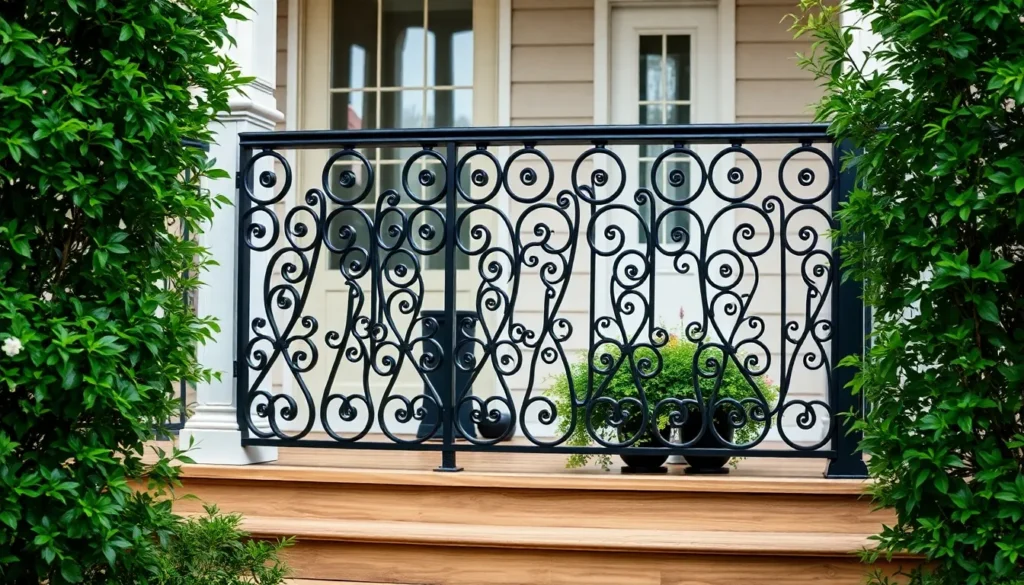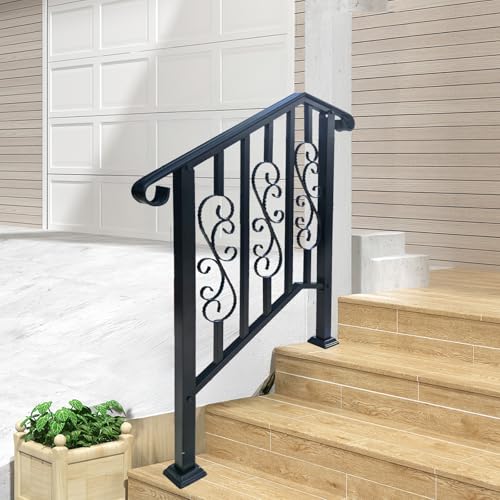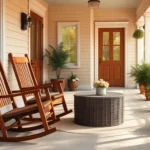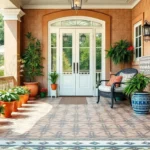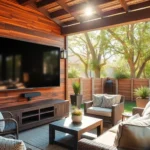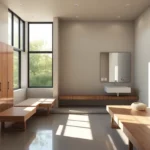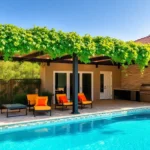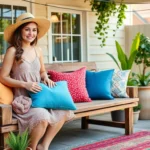We know that choosing the perfect porch railing can transform your home’s curb appeal from ordinary to extraordinary. Iron railings offer an unbeatable combination of durability, elegance, and versatility that’s made them a top choice for homeowners across America.
Whether you’re drawn to classic wrought iron designs or sleek modern styles, iron porch railings deliver both form and function. They’ll withstand harsh weather conditions while adding sophisticated charm that complements any architectural style – from Victorian cottages to contemporary homes.
We’ve curated the most inspiring iron porch railing ideas that’ll help you create a stunning entrance your neighbors will envy. From ornate scrollwork to minimalist geometric patterns, these designs prove that iron railings aren’t just practical – they’re statement pieces that reflect your personal style and boost your property value.
Classic Wrought Iron Scrollwork Designs
Classic scrollwork transforms ordinary porch railings into architectural masterpieces that define traditional elegance. These timeless patterns showcase the artistry of metalwork while providing the structural integrity your porch demands.
Traditional Curved Patterns
Flowing curves create visual rhythm that guides the eye naturally along your porch perimeter. We’ve seen how S-shaped scrolls, C-curves, and wave patterns add movement to static railings while maintaining structural stability. These designs work exceptionally well on Colonial, Georgian, and Federal style homes where symmetry matters most.
Double scroll patterns offer balanced proportions that complement wider porch spans without overwhelming the space. The interlocking curves create depth and shadow play throughout the day, improving your home’s dimensional appeal. Professional installers often recommend these patterns for porches spanning 12 feet or more.
Simple curved elements provide understated elegance for homeowners seeking classic appeal without excessive ornamentation. Single scroll designs work beautifully on cottage style homes, craftsman bungalows, and transitional architecture where clean lines meet traditional charm.
Victorian Inspired Ornamental Details
Elaborate rosettes serve as focal points within scrollwork panels, drawing attention to exact sections of your railing system. We recommend positioning these decorative elements at regular intervals to create visual anchors that break up longer stretches of railings. Cast iron rosettes typically feature intricate petal patterns or geometric designs.
Leaf motifs bring natural beauty to wrought iron compositions through realistic botanical interpretations. Grape leaves, oak leaves, and ivy patterns remain popular choices that complement garden settings and industry designs. These organic elements soften the industrial nature of iron while maintaining durability.
Decorative finials crown railing posts with distinctive character that reflects Victorian craftsmanship traditions. Spear points, acorn tops, and ball finials offer different aesthetic approaches depending on your home’s architectural personality. Custom finials can incorporate family crests or personalized design elements.
Timeless Spiral Motifs
Ascending spirals create ever-changing vertical movement that draws the eye upward toward your home’s entrance. These coiled patterns work particularly well on stepped porches where the railing follows sloped terrain. The spiral motion adds energy to otherwise static architectural elements.
Interconnected spiral chains form continuous patterns that flow seamlessly across multiple railing panels. We’ve observed how these designs create unity along extended porch frontages while allowing each panel to maintain individual character. The connecting spirals eliminate visual breaks that can fragment longer installations.
Compact spiral clusters concentrate decorative impact within smaller spaces, making them ideal for narrow porches or balconette applications. These tight formations provide maximum visual interest per square foot while keeping manufacturing costs reasonable. Mini spirals work exceptionally well when combined with straight balusters for contrast.
Modern Minimalist Iron Railing Styles
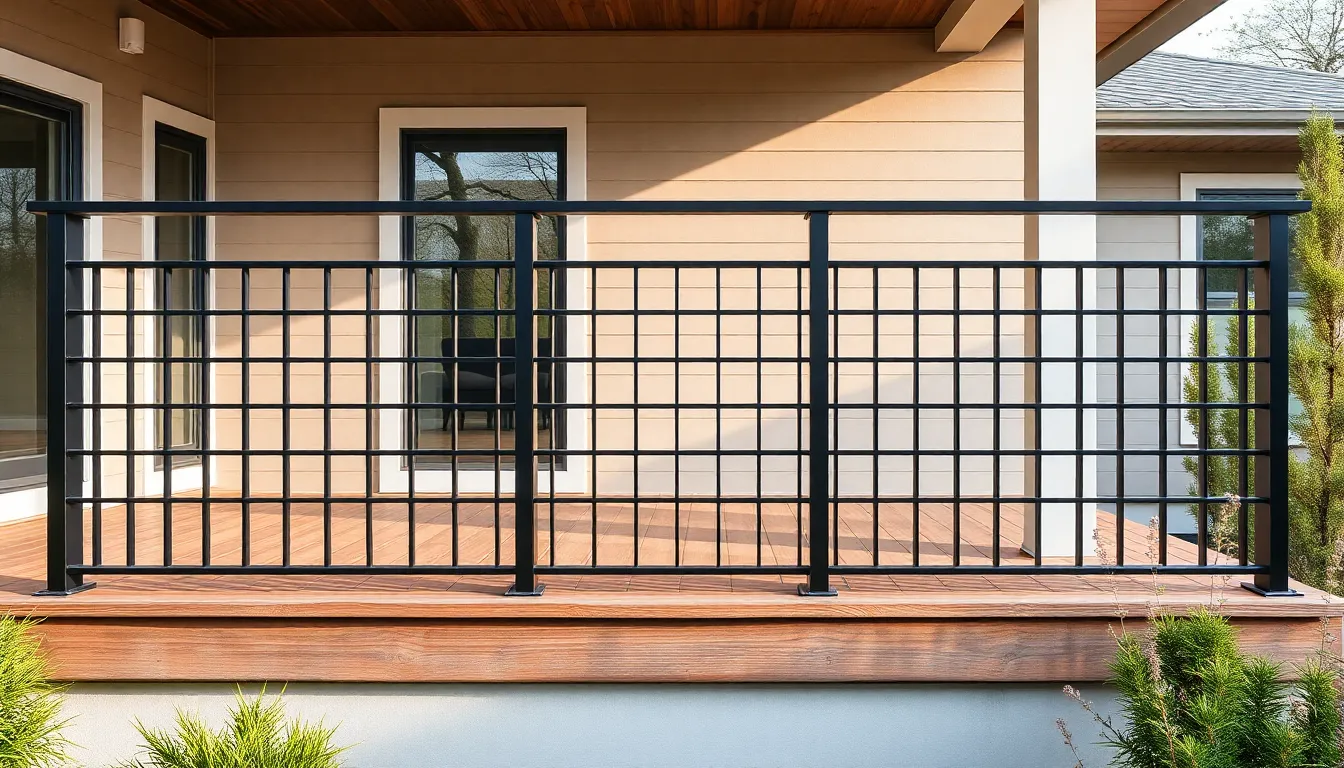
We’ve seen how traditional iron railings create stunning visual impact through ornate details. Modern minimalist iron railings take a completely different approach by emphasizing simplicity and clean shapes to enhance contemporary architecture.
Clean Geometric Lines
Geometric patterns transform simple iron railings into sophisticated architectural elements without overwhelming your porch design. Square and rectangular grids create balanced, uncluttered looks that complement modern home styles perfectly. Metal slats arranged in rectangular grid patterns work exceptionally well when framed with wood or metal handrails.
Black metal pipe frames featuring square or rectangular openings deliver minimalist yet structured appearances that enhance property value. These geometric designs add visual interest while maintaining the streamlined aesthetic that modern homeowners prefer. Linear arrangements provide subtle detailing that creates focal points without sacrificing the clean, contemporary feel.
Industrial-Inspired Designs
Raw materials define industrial iron railing designs that embrace functional minimalism with understated elegance. Black matte metal posts paired with mesh panels create striking visual contrasts while maintaining safety standards. Metal mesh panels provide both security and privacy while allowing excellent light and air circulation throughout your porch space.
Wire grids offer another industrial option that delivers durability and modern appeal in equal measure. These designs work particularly well when combined with natural elements like wood decks to soften the industrial edge. Strong, durable materials ensure longevity while the understated aesthetic complements various architectural styles seamlessly.
Contemporary Horizontal Bar Layouts
Horizontal bar railings represent the hallmark of contemporary iron porch design through their clean, linear appearance. Evenly spaced, slender horizontal bars keep porches feeling airy and inviting while providing necessary safety features. These railings create visual flow that pairs beautifully with wide wood planks on decks.
The horizontal orientation emphasizes openness without sacrificing structural integrity or security requirements. Contemporary layouts focus on simplicity and practicality while delivering elegant results that enhance curb appeal. These designs blend safety considerations with modern aesthetics to create sophisticated outdoor living spaces.
Decorative Iron Balusters and Spindles
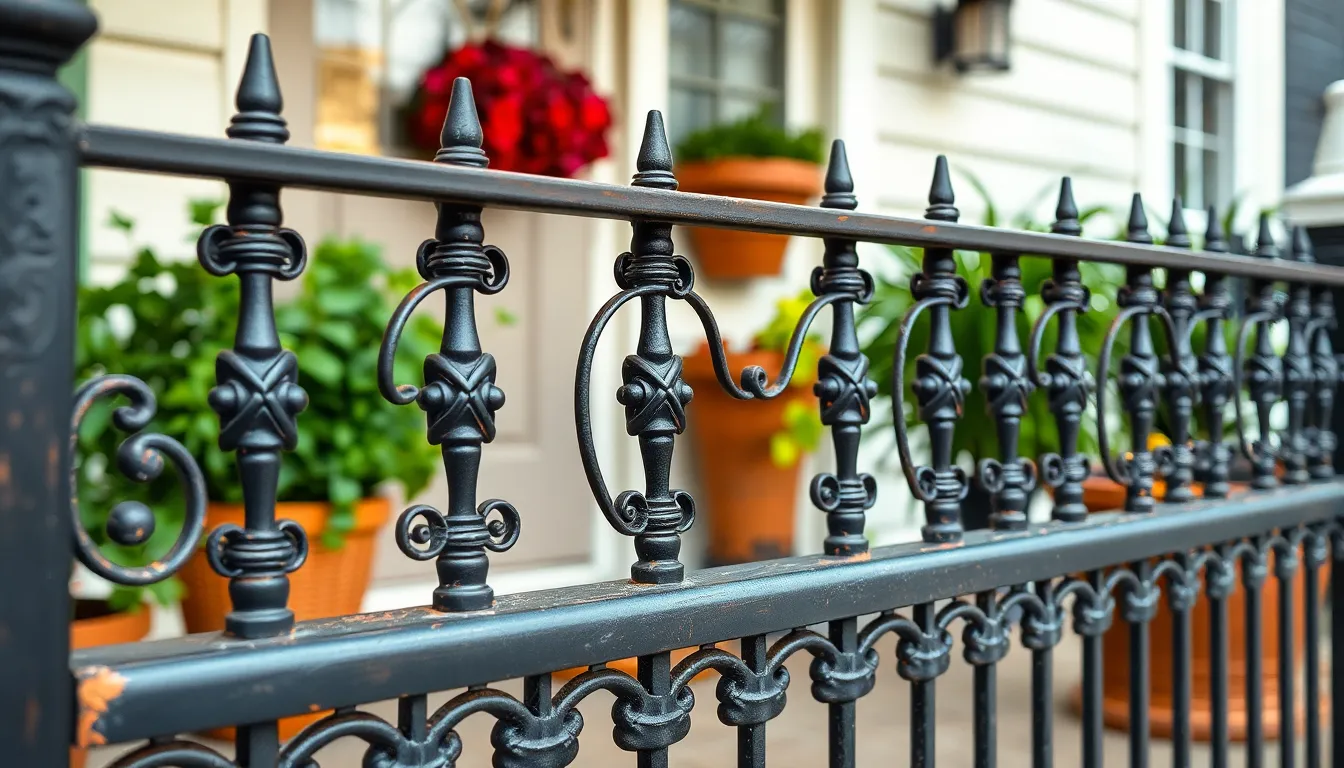
Decorative iron balusters and spindles serve as the foundation for creating stunning porch railings that blend safety with artistic expression. These intricate elements transform basic railing structures into eye catching architectural features.
Twisted Iron Spindle Patterns
Twisted iron spindles create visual texture through their sophisticated spiral craftsmanship. Artisans form these patterns by carefully twisting iron bars into elegant spirals that add complexity while maintaining structural integrity. We often see these designs used alone for dramatic impact or interspersed with straight vertical bars to create balanced compositions.
Modern installations frequently incorporate twisted patterns to complement both traditional and transitional architecture styles. Homeowners appreciate how these handcrafted elements provide sophisticated appeal without overwhelming the overall design. Professional installers recommend using twisted spindles strategically to draw attention to key areas like entry steps or porch corners.
Basket Weave Baluster Designs
Basket weave patterns offer a unique alternative to standard vertical balusters through their distinctive lattice appearance. Craftsmen create these designs by weaving flat or rounded iron bars in overlapping criss cross patterns that produce textured, artisanal qualities. This less common approach provides refined visual interest while maintaining the durability iron railings are known for.
Property owners choosing basket weave designs often pair them with simple frame rails to emphasize the intricate pattern work. These installations work particularly well on wider porch areas where the detailed weaving can be fully appreciated. Interior designers frequently recommend this style for homes seeking distinctive character that stands apart from conventional railing options.
Custom Forged Decorative Elements
Custom forging allows us to incorporate personalized ornamental accents that reflect individual style preferences. Skilled blacksmiths create unique decorative elements including floral motifs, geometric shapes, and thematic accents like leaves and flowers integrated directly into the ironwork. These bespoke details transform simple railings into statement pieces that complement exact architectural features.
Popular custom elements include scrolls, twists, and specialized basket weave combinations that enhance both artistic and functional aspects. Homeowners working with experienced craftsmen can develop designs featuring triple circle arches, Victorian inspired turned balusters, or modern geometric patterns arranged in sophisticated layouts. Custom bronze finishes and mixed vertical arrangements with ornamental balusters create personalized answers that increase property value while providing essential safety features.
Mixed Material Iron Railing Combinations
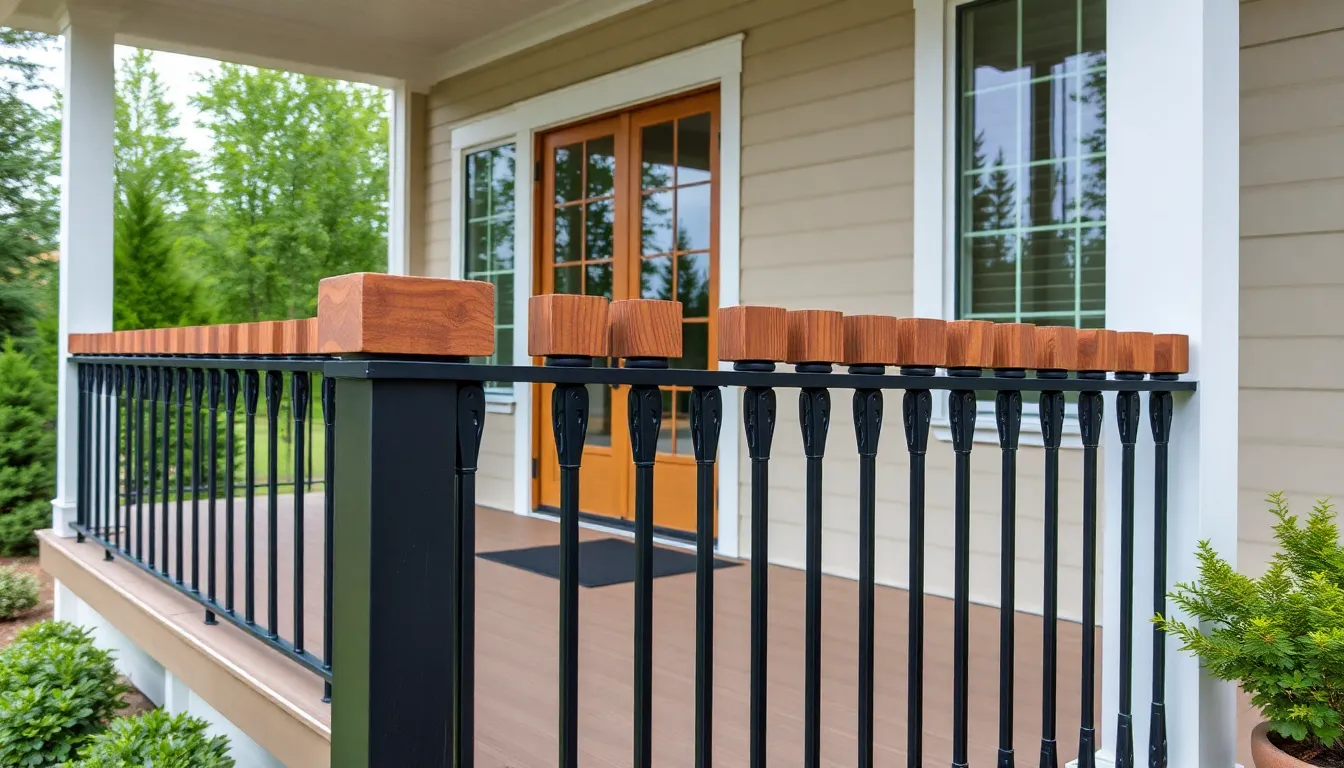
Combining iron with other materials creates ever-changing porch railings that offer both visual appeal and enhanced functionality. These hybrid designs allow us to achieve unique aesthetics while maximizing durability and style.
Iron and Wood Hybrid Designs
Iron and wood combinations bring together rustic warmth with sturdy metal craftsmanship for balanced, inviting porch railings. We often see iron balusters paired with wooden top rails or handrails, creating striking contrasts that complement various architectural styles. Horizontal metal pipes framed in unstained cedar produce an easy-on-the-eyes contrast that works beautifully with both traditional and contemporary homes.
Wood caps on iron newel posts add natural texture while maintaining iron’s structural strength, making porches both elegant and comfortable. These designs work particularly well when we want to soften iron’s industrial feel without sacrificing its durability. Cedar and redwood choices provide weather resistance while adding warmth to the metal framework.
Stone and Iron Integration
Stone pillars paired with iron railing elements create stately permanence and classic aesthetic appeal for grand outdoor spaces. Iron railings anchored between stone posts offer substantial support while creating visually striking material contrasts. This approach suits homes with elevated porches or stately architectural features, combining stone’s organic robustness with iron’s crafted intricacy.
Wrought iron scrollwork or geometric spindle designs complement stone bases perfectly, creating sophisticated transitions between materials. We recommend this combination for homeowners seeking impressive curb appeal with lasting structural integrity. Natural stone varieties like limestone, granite, or fieldstone work exceptionally well with both painted and natural iron finishes.
Glass Panel Iron Frame Systems
Glass panels framed with iron railings provide modern, minimalist options while preserving safety and unobstructed views. Sections of glass balusters alternating with iron pickets create clean, contemporary styles that complement natural surroundings. We can use 6-inch glass balusters combined with iron posts or horizontal iron bars for elegant, open porch feels.
These systems work particularly well for porches with scenic views, allowing homeowners to maintain sight lines while ensuring safety. Glass integration with boxed iron frames delivers sophisticated appearances that suit modern architectural styles. Tempered glass panels provide durability while iron frameworks offer structural support and visual definition.
Painted Iron Railing Color Schemes

Selecting the right paint color transforms iron porch railings from simple functional elements into striking design features. We’ll explore how different color choices can dramatically enhance your home’s exterior appeal while providing lasting protection.
Bold Statement Colors
Deep reds create dramatic focal points that complement brick exteriors and traditional architecture beautifully. Navy blue iron railings offer sophisticated elegance that pairs exceptionally well with white or cream colored homes. Forest green provides a natural, welcoming appearance that harmonizes with landscaping and outdoor environments.
Bold colors work best when they coordinate with your home’s existing color palette rather than competing with it. We recommend testing paint samples in different lighting conditions before making final decisions. Rich burgundy and hunter green shades maintain their vibrancy longer than brighter hues in outdoor settings.
Classic Black and White Options
Black remains the most popular choice for wrought iron railings because it delivers timeless elegance across all architectural styles. This traditional color enhances the natural beauty of ironwork details while providing versatile coordination with any exterior color scheme. Black iron railings create stunning contrasts against light colored homes and blend seamlessly with darker exteriors.
White iron railings brighten porch spaces and enhance curb appeal, especially on homes with lighter color palettes. Clean white finishes make porches appear larger and more inviting while showcasing decorative ironwork details effectively. Cream and off white variations offer softer alternatives that coordinate beautifully with warm toned exteriors.
Two tone combinations mixing black bases with white or colored accent details on scrolls and finials create subtle visual interest without overwhelming the overall design.
Weather-Resistant Finish Choices
Powder coating provides superior protection against rust, chipping, and fading compared to traditional paint applications. This durable finish maintains color integrity for years while reducing ongoing maintenance requirements significantly. Professional powder coating services ensure even coverage and long lasting results for outdoor iron railings.
Rust inhibitive primers combined with high quality enamel or epoxy topcoats offer excellent moisture and UV protection for painted iron surfaces. These multi layer systems create barriers that prevent corrosion from developing beneath the finish. Galvanized iron with zinc coating adds another layer of corrosion resistance before paint application.
Regular maintenance inspections help identify potential issues before they compromise the protective finish, extending the life of your painted iron railings considerably.
Rustic and Farmhouse Iron Railing Ideas
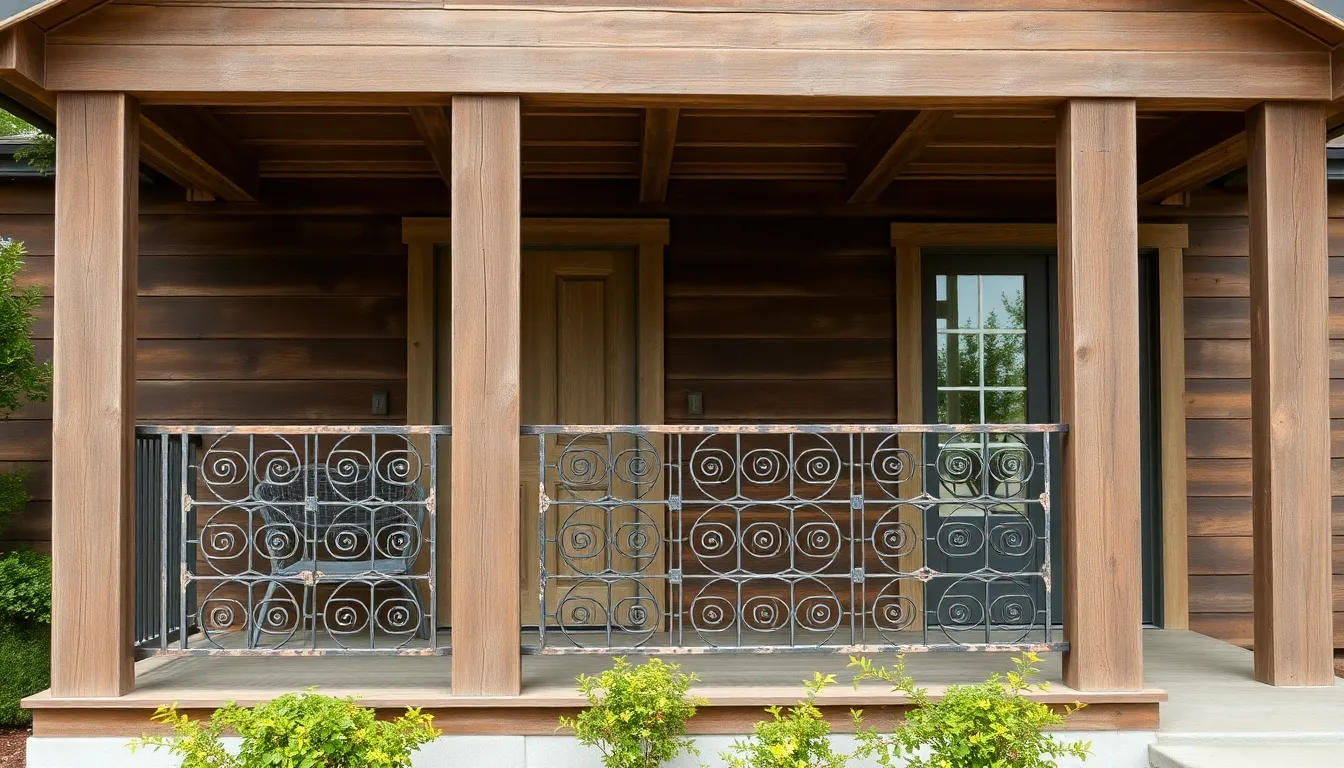
Building on modern railing designs, we shift our focus to rustic and farmhouse iron railings that embrace weathered beauty and countryside charm. These styles create welcoming outdoor spaces that feel both timeless and lived in.
Distressed Metal Finishes
Distressed metal finishes transform new iron railings into pieces that look like they’ve weathered decades of country living. We achieve this authentic rustic appearance through artificial aging techniques that create natural patina development on wrought iron surfaces. The weathered look adds character and historical depth to farmhouse porches.
Traditional distressing methods include sandblasting, chemical treatments, and hand rubbing techniques that create unique textures and color variations. Bronze and antique green finishes particularly complement rustic exteriors, offering that coveted vintage charm typical of farmhouse aesthetics. We often see these finishes paired with natural wood elements to enhance the overall countryside appeal.
Raw metal textures work exceptionally well for industrial inspired rustic designs, where matte black iron creates striking contrasts against natural materials. These finishes require minimal maintenance while delivering maximum visual impact for modern farmhouse homes.
Simple Country-Style Patterns
Simple country style patterns focus on clean, understated designs that echo traditional rural architecture. We favor straightforward approaches using vertical bars, horizontal frames, and basic geometric shapes like diamonds and squares. These patterns complement farmhouse exteriors without overwhelming the overall design aesthetic.
Linear frame designs create structured yet welcoming appearances that work beautifully with both classic and contemporary farmhouse styles. Vertical wrought iron balusters combined with wood posts provide that perfect balance of warmth and durability we seek in country designs. Diamond patterns arranged in repeating sequences add visual interest while maintaining the simplicity that defines farmhouse charm.
Geometric shapes integrated into railing designs offer versatility for different porch configurations. Square grids and rectangular patterns create balanced compositions that enhance rather than compete with architectural details. We find these straightforward designs particularly effective for stepped porches and wraparound applications.
Reclaimed Iron Material Options
Reclaimed iron materials bring authentic history and sustainable craftsmanship to modern farmhouse projects. We source these materials from old structures, barns, and industrial buildings, preserving unique imperfections and textures that new iron simply cannot replicate. Each piece tells its own story through distinctive wear patterns and natural aging.
Salvaged wrought iron components offer one of a kind character with hand forged details that showcase traditional metalworking techniques. These materials often feature subtle variations in thickness, surface texture, and color that create truly custom appearances. We appreciate how reclaimed iron contributes to authentic farmhouse aesthetics while supporting sustainable building practices.
Vintage iron elements can be restored and integrated into new railing systems, combining historical preservation with modern safety standards. Old gate hardware, decorative brackets, and ornamental pieces become focal points that distinguish custom farmhouse railings from mass produced alternatives. The craftsmanship from past eras adds irreplaceable authenticity to contemporary rustic designs.
Safety-Focused Iron Railing Designs

Safety stands as the foundation of exceptional iron railing design, ensuring your family’s protection while maintaining aesthetic appeal. We’ll explore essential safety elements that combine robust engineering with beautiful ironwork to create secure outdoor spaces.
Code-Compliant Height Requirements
Building codes establish exact height standards that our iron railings must meet to ensure proper protection. The International Residential Code (IRC) and International Building Code (IBC) require guardrails on elevated porches to measure at least 36 inches from the porch surface. Local jurisdictions often increase this requirement to 42 inches for enhanced safety measures.
Stair handrails attached to porches require different measurements, ranging between 34 and 38 inches in height. Railings become mandatory on any porch or deck elevated more than 30 inches above ground level to prevent accidental falls. We recommend consulting your local building department to verify exact requirements in your area before installation.
Child-Safe Spacing Considerations
Proper spacing between iron railing elements protects children from potential hazards while maintaining visual appeal. The critical 4-inch rule governs baluster spacing, ensuring no opening allows a 4-inch sphere to pass through. This prevents small children from slipping between vertical members or getting their heads stuck.
Triangular openings created where stair treads meet railings require special attention, limiting passage to spheres smaller than 6 inches. We design our iron railings with consistent spacing measurements throughout the entire system. Testing with actual measuring tools during installation ensures compliance with these life-saving safety standards.
Sturdy Construction Features
Structural integrity forms the backbone of safe iron railing systems through rigorous engineering standards. Balusters and infill panels must withstand lateral forces of at least 125 pounds per square foot during testing. Top rails require even greater strength, supporting concentrated loads up to 500 pounds and uniform loads of 125 pounds per linear foot.
Installation demands secure anchoring systems using proper brackets and fasteners designed for long-term stability. Engineers incorporate a safety factor of 2.5 into structural calculations, providing extra durability beyond minimum requirements. We ensure all welds and joints meet professional standards, eliminating weak points that could compromise safety over time.
Budget-Friendly Iron Railing Solutions
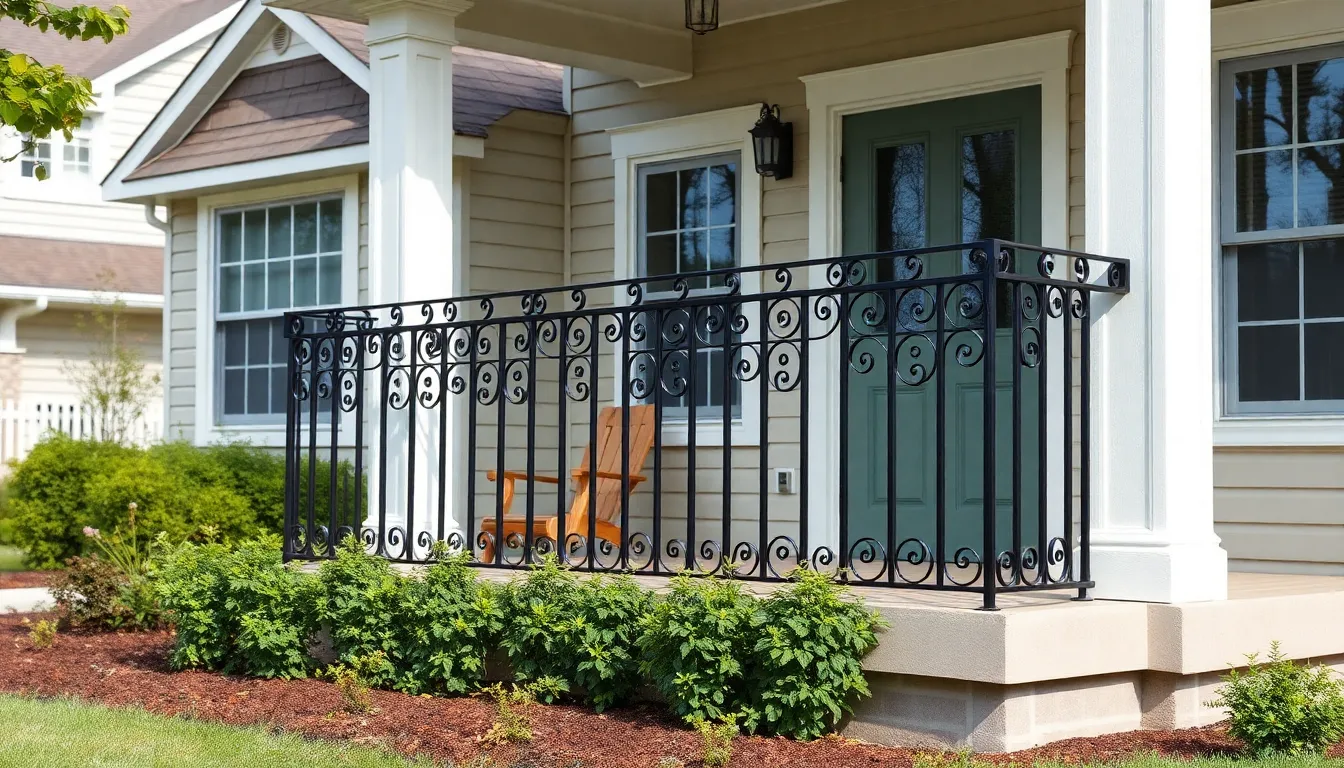
Creating beautiful iron porch railings doesn’t have to break your budget. Smart planning and strategic choices can help you achieve the elegant look you want while keeping costs manageable.
DIY Installation Options
Pre-Fabricated Iron Railing Kits offer the perfect entry point for homeowners with moderate DIY skills who want to save on labor costs. These standardized sections work especially well for straightforward porch layouts where custom fabrication isn’t necessary.
Installing simple railing sections becomes much more manageable when you choose kits with standard dimensions that don’t require specialized tools or welding expertise. Most kits include clear instructions and all necessary mounting hardware.
Maintaining your iron railings yourself extends their lifespan significantly while reducing ongoing maintenance expenses. Regular cleaning, touch-up painting, and rust prevention can be handled with basic tools and materials from your local hardware store.
Pre-Fabricated Iron Railing Kits
Standardized panels and components make these kits an economical choice for quick porch updates without sacrificing quality or safety. Each kit typically includes balusters, posts, panels, and all mounting hardware needed for installation.
Style variety within budget constraints allows you to choose from traditional ornate designs to modern minimalist options. Many manufacturers offer different finishes and decorative elements while maintaining affordable price points.
Quick installation timelines become possible with pre-fabricated systems that can transform your porch in a weekend rather than weeks of custom work.
Cost-Effective Design Alternatives
Simple horizontal and vertical bar designs focus on clean lines that reduce fabrication complexity while maintaining durability and visual appeal. These straightforward patterns require less metal and labor-intensive work than ornate scrollwork.
Mixed material approaches combine iron frames with wood panels or glass elements to create visually striking railings while reducing the amount of expensive metal needed. This strategy maintains structural integrity while cutting material costs.
Steel and aluminum alternatives provide similar strength and appearance to wrought iron at significantly lower price points. These materials offer excellent durability without the premium cost associated with traditional wrought iron.
Modern minimalist and industrial styles emphasize function over elaborate ornamentation, requiring fewer decorative details and less complex fabrication. These designs still add elegance and safety to your porch while keeping expenses under control.
Maintenance and Care Tips for Iron Railings
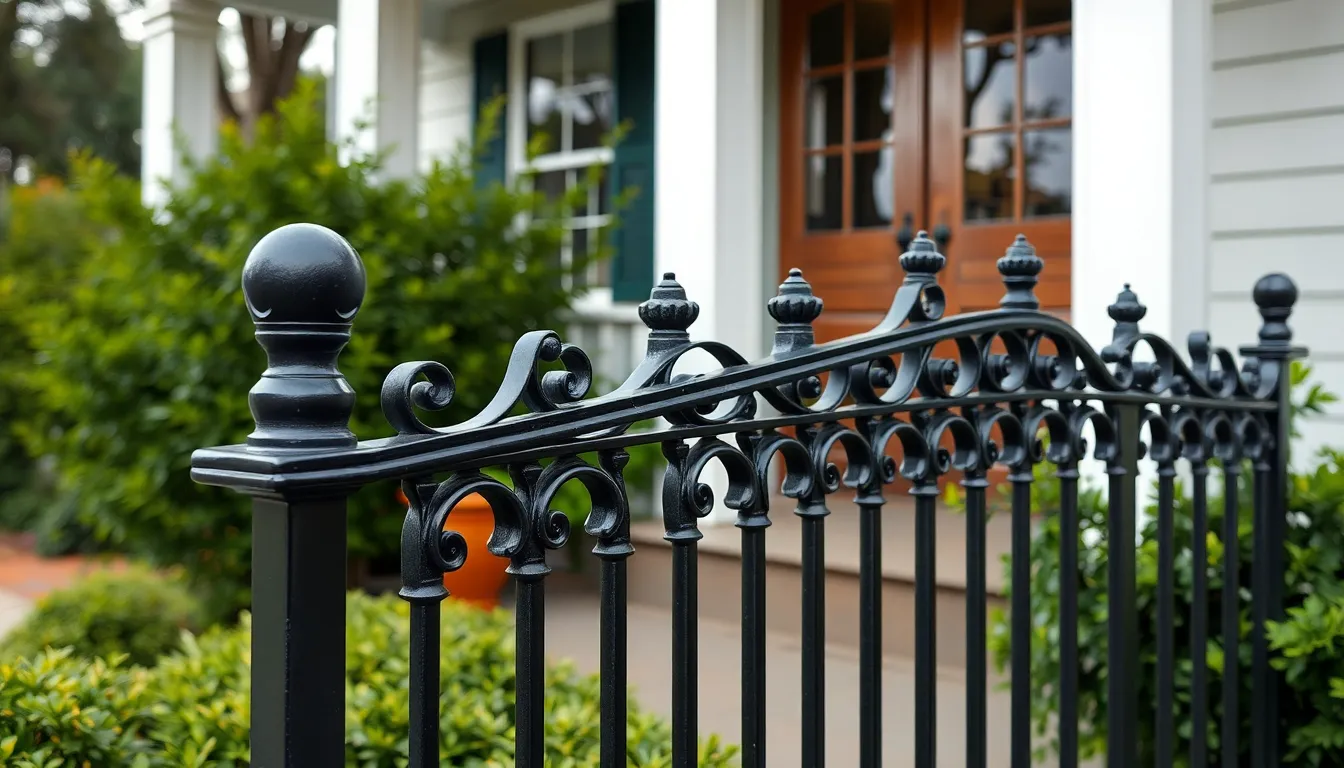
Proper maintenance ensures your iron porch railings remain beautiful and functional for decades. We’ll share expert strategies to protect your investment and keep your railings looking their best.
Rust Prevention Strategies
Choose powder-coated or galvanized iron railings for enhanced rust resistance from the start. These modern coating methods provide superior protection compared to traditional paint finishes and offer multiple color options to match your home’s aesthetic.
Apply rust-inhibiting primers and paint at the first sign of rust or corrosion. Early intervention prevents small rust spots from becoming major structural problems that require expensive repairs or replacement.
Remove existing rust immediately using wire brushes or sandpaper before applying new protective coatings. Thorough rust removal ensures primer and paint adhere properly and provides lasting protection against future corrosion.
Keep railings dry and address water accumulation promptly to prevent rust formation. Standing water accelerates oxidation and creates ideal conditions for rust development on iron surfaces.
Regular Cleaning Techniques
Clean iron railings every three months or as needed to maintain their appearance and protective coatings. Regular cleaning prevents dirt buildup and allows you to spot potential issues before they become serious problems.
Use warm water with mild dish soap and a soft-bristle brush or sponge to remove dirt and grime effectively. This gentle approach protects protective coatings while thoroughly cleaning decorative elements and hard-to-reach areas.
Rinse thoroughly and dry with a soft cloth after cleaning to prevent water spots and mineral deposits. Complete drying prevents moisture from lingering in crevices where rust could develop.
Avoid harsh chemicals or abrasive tools that can damage protective coatings and expose bare metal to moisture. Gentle cleaning methods preserve your railings’ finish and extend their lifespan significantly.
Long-Term Preservation Methods
Conduct visual inspections twice a year, especially after harsh weather like winter storms or heavy rains. Look for rust spots, bubbling paint, loose bolts, cracked welds, or damaged decorative parts that require immediate attention.
Tighten loose bolts and fix structural weaknesses during inspections to ensure stability and safety. Addressing minor issues promptly prevents them from becoming major structural problems that compromise your railing’s integrity.
Clear debris and vegetation around railings to reduce moisture retention and prevent damage from organic matter. Leaves, branches, and other debris trap moisture against metal surfaces and accelerate corrosion.
Consider professional inspections and repainting every few years to maintain protective coatings and address wear from weather exposure. Professional services ensure proper surface preparation and application techniques for maximum protection.
Replace severely corroded or structurally compromised railings when necessary to maintain safety and appearance. Timely replacement prevents accidents and maintains your home’s curb appeal and property value.
Conclusion
We’ve explored countless ways iron porch railings can transform your home’s exterior into something truly special. From ornate Victorian scrollwork to sleek modern minimalism these versatile design elements offer endless possibilities for every architectural style and budget.
The beauty of iron railings lies in their perfect balance of form and function. Whether you’re drawn to classic wrought iron patterns or prefer contemporary geometric designs you’ll find options that enhance your home’s curb appeal while providing essential safety features.
Remember that proper maintenance and quality installation are key to maximizing your investment. With the right care your iron porch railings will continue adding value and visual appeal to your home for decades to come. Start planning your iron railing project today and discover how this timeless material can elevate your outdoor living space.
Frequently Asked Questions
What are the main benefits of choosing iron porch railings?
Iron porch railings offer exceptional durability, elegant appearance, and versatility in design. They can withstand harsh weather conditions while enhancing both classic and modern architectural styles. Iron railings serve as both practical safety elements and stylish statement pieces that can significantly increase your property value.
What’s the difference between traditional and modern iron railing designs?
Traditional iron railings feature ornate scrollwork, curved patterns, and Victorian-inspired details like rosettes and leaf motifs. Modern designs emphasize clean lines, geometric patterns, and minimalist aesthetics. Contemporary styles often include horizontal bars, industrial elements, and simple geometric shapes that complement modern architecture.
Can I combine iron railings with other materials?
Yes, iron railings work beautifully with other materials. Popular combinations include iron and wood hybrids for rustic warmth, iron with stone pillars for a stately look, and iron frames with glass panels for modern, unobstructed views. These mixed-material designs create visually appealing and functional porch railings.
What are the best paint colors for iron railings?
Classic black is the most popular choice as it enhances ironwork details and never goes out of style. White brightens spaces and showcases decorative elements. Bold colors like deep red, navy blue, or forest green can make statement pieces. Always coordinate with your home’s existing color palette.
Are there budget-friendly iron railing options?
Yes, pre-fabricated iron railing kits offer cost-effective solutions for DIY installation. Simple horizontal and vertical bar designs reduce costs, and steel or aluminum alternatives provide similar appearance at lower prices. Mixed materials and minimalist styles can also help keep expenses manageable while maintaining quality.
How do I maintain iron railings to prevent rust?
Choose powder-coated or galvanized iron railings for enhanced rust resistance. Clean regularly with gentle methods to preserve protective coatings. Conduct biannual inspections and address minor rust spots immediately. Apply rust-inhibitive primers and consider professional maintenance for long-term preservation.
Do iron railings need to meet specific safety codes?
Yes, iron railings must meet code-compliant height requirements and child-safe spacing standards. Proper structural integrity requires secure anchoring systems and rigorous engineering standards. Always ensure your railings meet local building codes for both safety and legal compliance.
Can I install iron railings myself?
Pre-fabricated iron railing kits are designed for moderate DIY skills and include clear instructions with necessary hardware. These standardized sections simplify installation and can save significant labor costs. However, complex custom designs may require professional installation to ensure proper safety and structural integrity.

